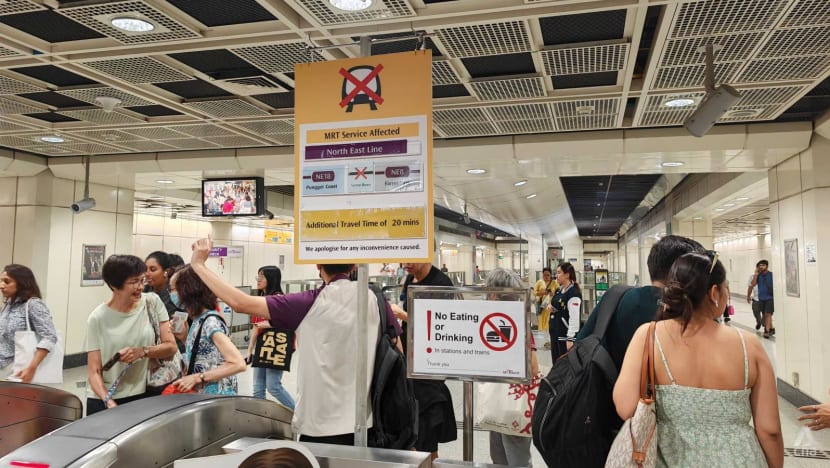MRT reliability falls in August as LTA releases first monthly report on rail performance
Rail reliability over the last 12 months hit its lowest point in June, but it has improved since.

Commuters at Farrer Park MRT station after a power fault led to a disruption of train services on the North East Line on Aug 12, 2025. (Photo: CNA/Koh Wan Ting)

This audio is generated by an AI tool.
SINGAPORE: The reliability of the MRT network declined in August, according to the Land Transport Authority's (LTA) first monthly report on rail reliability on Friday (Oct 10).
Updates had previously been provided on a quarterly basis.
"This revised monthly cadence is part of our ongoing efforts to improve transparency and accountability, and to provide the public with a clearer picture of how our rail network has been performing over time," said LTA in a press release.
LTA publishes its reliability figures using a 12-month moving average of mean kilometres between failures (MKBF) – a metric that measures train reliability.
This tracks the average distance that a train travels before it encounters a delay of more than five minutes.
According to the report, the MKBF for the MRT network decreased to 1,740,000 train-km as of the end of August, from 1,818,000 train-km at the end of July.
The authority has set an MKBF target of 1 million train-km for the MRT network.
The Downtown Line's (DTL) MKBF fell from 4,131,000 train-km at the end of July to 2,760,000 train-km at the end of August, while the North East Line's (NEL) MKBF fell from 4,262,000 train-km to 2,142,000 train-km.
“These were due to one delay on each line in August 2025, reflecting the sensitivity of MKBF to small variations in the number of delays above 1 million train-km,” said LTA.
The East-West Line also saw its MKBF fall from 2,021,000 train-km at the end of July to 1,684,000 train-km the following month.
Both the North-South Line (NSL) and Circle Line (CCL) saw increases in their MKBF since the end of July.
The NSL’s MKBF rose from 1,413,000 train-km to 1,648,000 train-km, and the CCL’s increased from 1,067,000 train-km to 1,245,000 train-km.
“LTA will continue to provide monthly updates on the MKBF for the overall MRT network as well as for individual rail lines,” said the transport authority.
There were four delays on the MRT network that lasted more than 30 minutes this year. Two of the four were in August.
“LTA has been publishing the number of delays lasting more than 30 minutes in the rail reliability report, to reflect the frequency of more severe disruptions,” said the transport authority.
There were seven such disruptions on the MRT network in 2024.
THOMSON-EAST COAST LINE
The transport authority added that it would start publishing the MKBF performance and number of delays lasting more than 30 minutes for the Thomson-East Coast Line (TEL) from this edition of the report.
According to the report, the TEL's MKBF fell to 311,000 train-km from the end of August from 373,000 train-km at the end of July.
“While MKBF provides a reasonable indicator for the reliability of mature rail lines, its limitations can make it less reflective of the reliability of a newer line,” said LTA.
"A newer rail line in its early stages tends to operate significantly lower mileage, as the overall line is shorter, and given relatively lower ridership, trains are not being operated at more typical frequencies.
"In addition, the operation of new lines, especially lines that are still undergoing construction and extension, will take time to stabilise."
According to LTA, the TEL is currently in its initial engineering “bathtub” stage - a period when teething issues are expected as the system stabilises and matures.
“Since the start of the phased opening of the TEL, LTA and the operator have been working with the Original Equipment Manufacturers (OEM) to resolve teething issues.”
These include issues with the new signalling system of the TEL, which LTA and the operator have been working with the OEM to address, it said.
“Issues that arise in the initial stages of operations and after system updates as part of ongoing works may result in delays. Such issues differ from the faults encountered in the operation of more mature rail lines.”
Despite this, the transport authority said it would commence reporting the TEL’s MKBF since the line had so far accumulated one year of "more representative data".
"The TEL project is not fully complete, as works on TEL Stage 5 are still underway by LTA, the operator and OEMs. More time is needed before the TEL’s performance stabilises," LTA said.
"We expect the performance of the TEL to improve after it fully opens in 2026 and its operations have stabilised, such that its fault trends can be fairly compared with our other mature lines."
LRT
The MKBF for the overall LRT network fell from 442,000 train-km at the end of July to 420,000 train-km at the end of August.
The Sengkang-Punggol LRT's MKBF dipped from 1,256,000 train-km to 840,000 train-km, while the Bukit Panjang LRT's MKBF rose from 192,000 train-km to 209,000 train-km.
There were four delays lasting more than 30 minutes on the LRT network this year, with two in August.
RELIABILITY MEASURES
While the MKBF remains a "simple and internationally recognised indicator" of rail reliability, it does not reflect the length of each disruption and the actual impact on commuters, said the transport authority.
The number of delays lasting more than 30 minutes will be published monthly as well.
"LTA will also look into sharing more indicators publicly, such as the proportion of scheduled mileage travelled by revenue trains, as well as the punctuality of trains reaching each terminus station," it said.
“Such indicators would allow us to provide more international comparisons with other major overseas metros that publish similar indicators but not MKBF,” said LTA.
It said it is studying additional metrics that better reflect the impact of rail disruptions on commuters.
Preliminarily, this could include the number of commuter trips affected by rail disruptions, taking into account the extent and duration of disruptions. These new indicators will be included in the next rail reliability report, said LTA.
RELIABILITY OVER THE YEARS
The reliability of the MRT network strengthened from 2020 to 2022, with its MKBF rising from 1,451,000 train-km in 2020 to 2,089,000 train-km in 2022.
But it dipped in the following two years, falling to 2,077,000 train-km in 2023 and sliding further to 1,982,000 train-km in 2024.
For the LRT network, its reliability increased from 2020 to 2023, when the MKBF hit 546,000 train-km. This was more than twice its MKBF in 2020.
However, this figure fell in 2024 to 382,000 train-km.
Listen:
According to the report, Singapore’s MRT system had a higher MKBF than rail networks in other cities.
The MRT network recorded an MKBF of 8,386,000 car-km from September 2024 to August 2025.
Hong Kong's MTR came in at 4,289,769 car-km from April 2025 to June 2025, while the New York City subway recorded 192,000 car-km from September 2024 to August 2025.
Taipei's metro reported 19,116,000 car-km from January 2023 to December 2023.
LTA said the data was drawn from the latest publicly available sources and serves as a "broad comparison", given that the detailed calculation methodology and reporting periods differ from metro to metro.

















